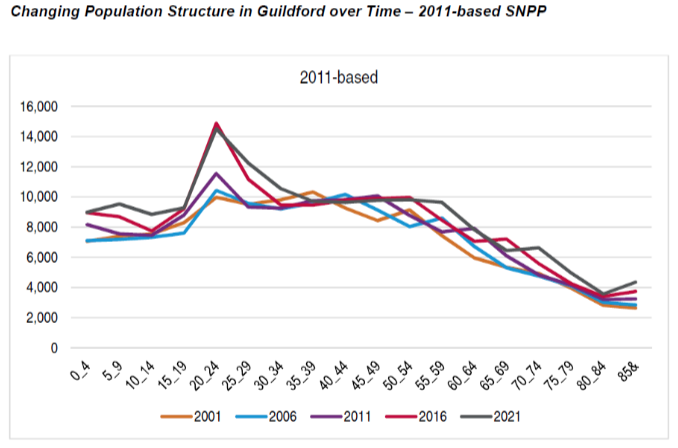 Abraham Lincoln
If given the truth, the people can be depended upon to meet any national crisis...
Abraham Lincoln
If given the truth, the people can be depended upon to meet any national crisis...
 Guildford news...
for Guildford people, brought to you by Guildford reporters - Guildford's own news service
Guildford news...
for Guildford people, brought to you by Guildford reporters - Guildford's own news service
Letter: Further Analysis Shows ONS’s Population Forecasting Is Deficient
Published on: 10 Jul, 2021
Updated on: 10 Jul, 2021
I believe that the methodology used by the ONS to count the student population generally has had a profound effect on both the population projections and the household projections for Guildford.
If my assumptions are correct, I would expect similar distortions in the population projections and household projections for other university towns. If, for instance, you compare the ONS SNPP’s (subnational population projections) for a number of typical university towns for the year 2011 with their actual populations as measured in the 2011 Census, you get the following:
 In every case, the population projections are significantly higher than that measured in the 2011 Census.
In every case, the population projections are significantly higher than that measured in the 2011 Census.
This tells us three things:
(1) that the ONS methodology for arriving at population projections must, in these instances, be incorrect
2) that in each case the ONS has over-estimated the populations of these towns and
(3) because they are all university towns, it is likely that the error relates to the way students are counted. The consequences that I would expect to find for university towns are as follows:
Un-attributable Population Change (UPC)
As we have seen, the 2011 Census has recorded significantly smaller populations in a number of university towns than had been projected by the ONS. For instance, the 2011 Census recorded a population for Guildford significantly less than had been forecast by the ONS and suggested that this discrepancy (referred to as Un-attributable Population Change or UPC) was probably due to the under-reporting of overseas students returning home.
See also: Opinion – The Real Problem With Our Housing Supply
In Guildford, the UPC in the period from 2001 to 2011 averaged -717 persons per annum. This discrepancy was so significant that, if an allowance for UPC had been applied, the housing need for Guildford to accommodate demographic indicators would be reduced to 239 homes per annum as opposed to 562 homes per annum in the current Local Plan.
High net international migration
I would expect other university towns with a high proportion of overseas students to have much higher figures for net international migration than neighbouring towns without a student population.
If you simply take natural growth (births and deaths) and net internal migration (movement within the UK), the 2012 Based SNPP forecast the population of Guildford to actually decline by 1800 by the year 2031.
The overall projected increase in Guildford’s population to 161,300 in 2031 was entirely due to the projected growth in net international migration of 23,100, of which, according to the Office for National Statistics, 57% were thought to be foreign students (see page 29 paragraph 2.50 West Surrey SHMA May 2014).
By comparison, Woking, a similar town only six miles away, but with no university and a low student population, has a net international migration figure of almost zero for the same period.
The movement of overseas students is partly recorded by the International Passenger Survey which shows a gap between the numbers of immigrants arriving to study and the numbers of emigrants who had previously immigrated to study.
This gap could be a result of a number of factors including the IPS not completely recording student flows, either due to sampling or non-sampling errors. This problem would be resolved if overseas students were simply removed from statistics for international migration on the basis that they are only here on a temporary basis to study.
Higher than usual household projections
I would also expect other university towns to have higher than usual household projections.
In the 2011 Census, unlike in the previous census, students were counted as being usually resident at their term-time address rather than at their home address. Moreover, overseas students, who had no usual address in the UK, were counted as usually resident in their halls of residence regardless of how long they intended to stay here.
Because Guildford has such a large student population, and because they are counted as residents, Guildford appears to have a very high proportion of people in the 18-24 year age bracket (see below) who are assumed to have a high probability of forming new households, starting families and settling in Guildford, when, in reality, students move away from Guildford at the end of their studies.
This problem would be resolved if, for the purposes of projecting household formations, the home address of students should be taken as their permanent place of residence.
Conclusion
The fact that, in a number of instances, ONS population projections overestimate the populations of university towns clearly demonstrates that the ONS methodology must be deficient in some areas.
It is my contention that the housing need for Guildford, and for university towns generally, is probably inflated by deficiencies in recording the emigration of overseas students on completion of their studies and by recording students as permanent residents at their term-time address.
The unintended consequence for Guildford of counting students in this way is that Guildford appears to have a very high housing need which has resulted in more than 1200 hectares being removed from the green belt. Students in higher education represent a churn in the population and should not be counted as permanent residents for the purposes of estimating household formations.
Responses to Letter: Further Analysis Shows ONS’s Population Forecasting Is Deficient
Leave a Comment Cancel replyPlease see our comments policy. All comments are moderated and may take time to appear.
Recent Articles
- Guildford Institute’s Crowdfunding Project for Accessible Toilet in its New Community and Wellbeing Centre
- Letter: Guildford – Another Opportunity Missed?
- Letter: GBC’s Corporate Strategy – Where Is the Ambition?
- My Memories of John Mayall at a Ground-breaking Gig in Guildford Nearly Six Decades Ago
- Westborough HMO Plans ‘Losing the Heart of the Street’ Says Resident
- College Invests to Boost Surrey’s Economy and Close Digital Skills Gap
- Community Lottery Brings Big Wins for Local Charities
- GBC Housing Plan Promises ‘A Vibrant Urban Neighbourhood’ Near Town Centre
- Hospital Pillows ‘Shortage’ at the Royal Surrey
- Updated: Caravans Set Up Camp at Ash Manor School


Recent Comments
- Ian Macpherson on Updated: Main Guildford to Godalming Road Closed Until August 1
- Sara Tokunaga on GBC Housing Plan Promises ‘A Vibrant Urban Neighbourhood’ Near Town Centre
- Michael Courtnage on Daily Mail Online Reports Guildford Has Highest-paid Council Officer
- Alan Judge on GBC Housing Plan Promises ‘A Vibrant Urban Neighbourhood’ Near Town Centre
- John Perkins on GBC Housing Plan Promises ‘A Vibrant Urban Neighbourhood’ Near Town Centre
- S Collins on GBC Housing Plan Promises ‘A Vibrant Urban Neighbourhood’ Near Town Centre
Search in Site
Media Gallery
Dragon Interview: Local Artist Leaves Her Mark At One of England’s Most Historic Buildings
January 21, 2023 / No Comment / Read MoreDragon Interview: Lib Dem Planning Chair: ‘Current Policy Doesn’t Work for Local People’
January 19, 2023 / No Comment / Read MoreA3 Tunnel in Guildford ‘Necessary’ for New Homes, Says Guildford’s MP
January 10, 2023 / No Comment / Read More‘Madness’ for London Road Scheme to Go Ahead Against ‘Huge Opposition’, Says SCC Leader
January 6, 2023 / No Comment / Read MoreCouncillor’s Son Starts Campaign for More Consultation on North Street Plan
December 30, 2022 / No Comment / Read MoreCounty Council Climbs Down Over London Road Works – Further ‘Engagement’ Period Announced
December 14, 2022 / No Comment / Read MoreDragon Interview: GBC Reaction to the Government’s Expected Decision to Relax Housing Targets
December 7, 2022 / No Comment / Read MoreHow Can Our Town Centre Businesses Recover? Watch the Shop Front Debate
May 18, 2020 / No Comment / Read More











David Roberts
July 10, 2021 at 4:06 pm
This puts more facts and figures on what GGG and others have been saying for seven or eight years. Yet by the time the defective Guildford Local Plan has been reviewed in two years’ time, the building of thousands of unnecessary new houses will already have been approved and the rural character of villages like the Horsleys will be lost forever.
GBC should act now to restrict housebuilding approvals until the population figures are corrected and the real level of need established. The common-sense case for a non-committal moratorium is obvious but no one seems to have the courage to instruct council planning officers to halt the development juggernaut, even temporarily.